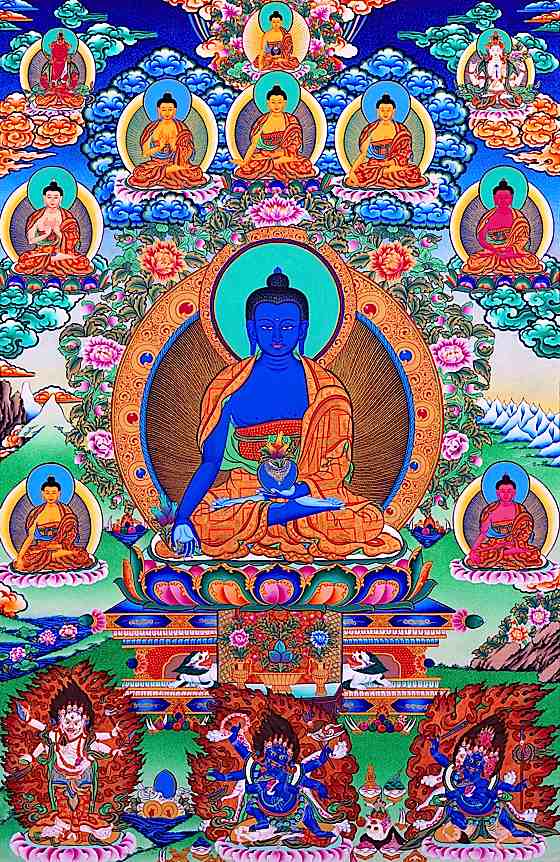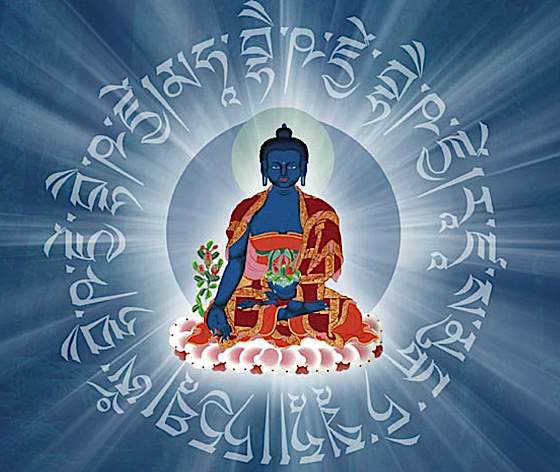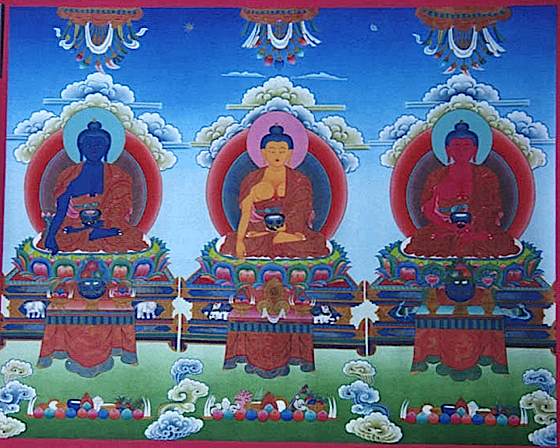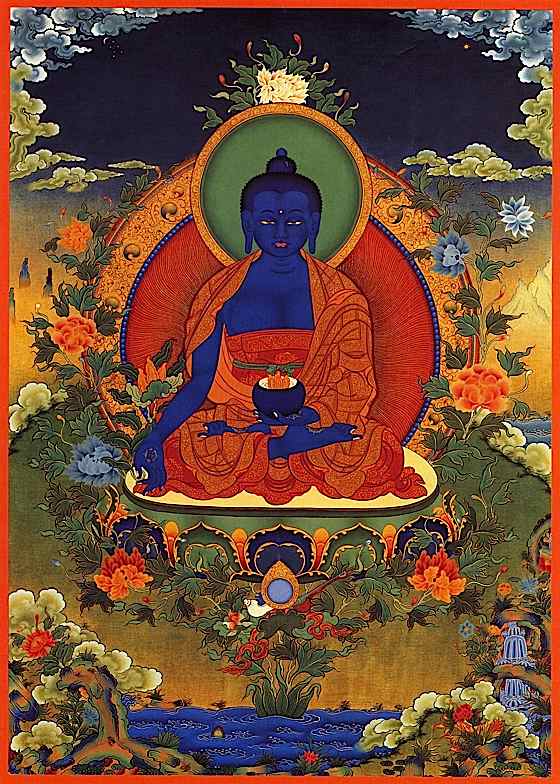Medicine Buddha Bhaisajyaguru
In times of pain, sickness, or stress, my first thought of remedy is quiet meditation with the most sacred Medicine Buddha mantra. Inevitably, arthritis pains subsides in my case, and I've avoided most of the colds and flu that go around my business meetings knock on wood. I give Medicine Buddha, exercise and good nutrition the credit. Chronic, advanced arthritis is mostly kept in check with Medicine Buddha practice and some occasional check-ins with the doctor.
Buddha.jpg">

Medicine Buddha and his brothers are an effective visualization and practice to help with illness or ill fortune. Here the Lapis Lazuli Medicine Buddha Bhaisajyaguru is surrounded by his Medicine Brother emanations and crowned top with Shakyamuni Buddha who not only taught Medicine Buddha practice he is considered a Medicine Buddha Himself.
Nor am I alone. Tibetan doctors rely on Medicine Buddha for their healings. Regular practice with the Medicine Buddha also empowers one with powers to heal others. In China and Japan, Medicine Buddha is a refuge in times of illness. Around the world, literally millions call out the name or mantra of Bhaisajyaguru. It is even written in the sutras that if you speak the name of the Medicine Buddha in the ears of a dying animal or human they will be ensured good rebirth regardless of their past karma. No wonder the Medicine Buddha is so popular.
A lovely chanted Medicine Buddha mantra sung in Sanskrit
My first choice for medicine short of obvious medical conditions requiring doctor interventions is a peaceful meditation on my visualization of Bhaishajyaguruor just Bhaishajyathe Medicine Buddha, and a few malas round of the very powerful mantra spelling is phonetic
TADYATHA AUM BHAISHAJYE BHAISHAJYE MAHA BHAISHAJYE BHAISHAJYE SAMUDGATE SVAHA
This is the sanskrit version where Om is really Aum of one version of the Medicine Buddha mantra as taught to me by my teacher. As found in the original sutra, theBhaiṣajyaguruvaiḍūryaprabhārāja Sūtra(भैषज्यगुरुवैडूर्यप्रभाराज सूत् this is most often given as:TADYATHA AUM BHAISHAJYE BHAISHAJYE MAHA BHAISHAJYA SAMUDGATE SVAHA
A beautiful chant to music of the Tibetan version of the Medicine Buddha Mantra:I chant in Sanskrit, as found in the sutra, even though I was taught the Tibetan pronunciation by my root guru and either is effective in my experience. I prefer Sanskrit by virtue of lineage to Shakyamuni Buddha via Sutra and by virtue of centuries of unbroken lineage from Tibetan teachers reaching back to Buddha.The Tibetan pronunciation is equally empowered:
Tayata Om Bhekandze Bekhandze Maha Bhekandze Bhekandze Randza Sumungate Soha
 Visualizing the Medicine Buddha Mantra and rays of healing Lapis Lazuli light emanating from the Buddha, and absorbed into the patient (or self) assists in healing.
Visualizing the Medicine Buddha Mantra and rays of healing Lapis Lazuli light emanating from the Buddha, and absorbed into the patient (or self) assists in healing.Visualizing the Buddha of Lapis Lazuli Light
Mantras are effective regardless of other practice, but visualizing the Medicine Buddha while chanting is very effective. Part of the visualization likely will include seeing the mantra emanating from Buddha. If you have empowerment with a guru, you can generally find this even more powerful if you self-generate as the Medicine Buddha.
In my tradition we visualize the seven Medicine Buddhas, but the simplest visualization is to see the Buddha a shining Lapis Lazuli blue Buddha, beautiful in radiance, perfect in all His features, in a monk’s robe in full lotus on the Lotus and moon throne. His face is serene and compassionate, and he has the features of a great Buddha. In his left hand is the Lapis-colored jar of medicine nectar, a medicine that not only cures all ills, but also negative karma, tensions, suffering, poverty and any other sufferings. In his right hand is the stem of the Myrobalan, with Aruna fruit, held between thumb and forefinger. He is surrounded by a glowing nimbus and aura of Lazuli-colored light and as you chant, his heart, throat and crown appear as glowing seed syllables Om (crown) Ah (throat) and Hum (heart). Then, healing light radiates from the Medicine Buddha’s heart, penetrating either your crown or heart, filling you with healing light, and driving out bad karma and sickness as visible black sludge and smoke. Often he is visualized with his two attendants Suryaprabha and Candraprabha, who are the sun and moon Bodhisattvas. In Soto and other Mahayana practices, you might also visualize the Twilve Warriors f Bhaisajyaguru, who relate directly to the twelve great vows of the Medicine Buddha (see below.)
The Seven Medicine Buddhas names in English are a powerful and lovely poetic expression in and of themselves.:
Bhaisajyaguru: Tathagatha Medicine Guru Lapis Lazuli King
Abhiyaraja: Tathagatha King of Clear Knowing
Dharmakirtisagara: Tathagatha Melodious Ocean of Dharma Proclaimed
Asokottamasriraja: Tathagatha Supreme Glory Free From Sorrow
Suvarnabhadradravimala: Tathagatha Stainless Excellent Gold
Svaragosaraja: Tathagatha King of Melodious Sound
Suparikirti-tanamasriraja: Tathagatha Glorious Renown of Excellent Signs
The eight is Shakyamuni Buddha, the Medicine Buddha of our era. When chanting the praises, I prefer the poetic Enlish names to the Sankrit, just because of the beautiful descriptions. In a full practice session or a puja, each of the Buddhas would receive His own praise.

In China and Japan, Bhaisajyaguru is part of the most important trinity of Buddhas, here shown in traditional form with Shakyamuni in the centre, Medicine Buddha on the right (of Shakyamuni, left to the viewer) and Amitabha Buddha on the opposite side.
Healing
Aside from visualizing and mantra recitation, a common healing practice is to chant 108 of Medicine Buddha’s mantras over a glass of water. The chanter, preferably one who has chanted the mantra in regular practice, then blows on the water and offers it to a sick person. The empowered water has healing powers. The patient can also be requested to speak the name of the Buddha 108 times, or chant the mantra, or read the sutras, or just to gaze up on a loving picture of the Medicine Buddha. Many miraculous cures have been attribute through the centres to the Medicine Buddha. From my own experience, when two tylenol do not work, the mantra certainly does.
Tibetan doctors tend to begin each day with Medicine Buddha practice, and when making herbal medicines chant the Mantras while working to further empower their medicinal benefits.
Most important to any healing, for a practicing Buddhist, is to dedicate the merit of any mantra chant or visualization or healing to the benefit of others, not to oneself. There is great healing power in Bodhichitta and dedicating the merit to others selflessly as the Medicine Buddha himself did in the twelve great vows before he became a Buddha see below.
Faith plays a role in healing, in that having absolute faith empowers practice, yet I have seen from past experience, as have many others, that chanting the Medicine Buddha Dharani or mantra for non-Buddhists who might have no faith is equally effective. The power is not all about faith.
 The Lapis Lazuli serenity of Medicine Buddha is healing.
The Lapis Lazuli serenity of Medicine Buddha is healing.Dharani of the Lord of Healing
In the sutras, Shakyamuni Buddha, the living Buddha of our age, taught the Dharani of the Medicine Buddha to benefit all beings, from gods to hell beings. Medicine Buddha is renowned not just for healing, but for His ability to neutralize past bad karma, His ability to bring good fortune to those in need, His ability to help us on the path to enlightenment, even His vows to release repentant prisoners. His Dharani in Sanskrit is:
Namo bhagavate bhaisajyaguru-vaidurya prabha-rajaya tathagataya arhate samyak- sambuddhaya tadyatha. Om bhaisajye bhaisajye bhaisajya-samudgate svaha!
This can be translated as: “I honour the Lord Master of Healing, the Kin of Lapis Lazuli Radiance, Tathagata, Arhat, Perfect Enlightened One, saying: To the healing, to the healing, to the supreme healing hail!” The last line of the Dharani is, of course, the short mantra.
Lazuli Pure Land East
His Lapis Lazuli Pure Land is in the east, but, in fact, he resides in your heart, always ready to help. Medicine Buddha has seven brothers, each with different praises and functions, or they can be thought of as manifestations of the same Medicine Buddha. He goes by many names, including:
• formal title: Bhaiṣajyaguruvaiḍūryaprabhārāja (भैषज्यगुरुवैडूर्यप्रभाराज, “Medicine Master and King of Lapis Lazuli Light”)
• Bhaisajyaguru — Medicine Guru in Sanskrit
• Bhaisajyaraja — Medicine King in Sanskrit
• Bhaisajya Samudgate — Supreme Healer in Sanskrit
• Sangye Menla — Supreme Healer in TibetanThe Twelve Vows
The twelve vows taken by Baishajyaguru, while he was a Bodhisattva, before he became a Buddha, are the key to understanding the unrestrained and growing popularity of the Lapus Lazuli Buddha. He selflessly swore:
1. I vow that my body shall shine as beams of brilliant light on this infinite and boundless world, showering on all beings, getting rid of their ignorance and worries with my teachings. May all beings be like me, with a perfect status and character, upright mind and soul, and finally attaining enlightenment like the Buddha.
2. I vow that my body be like crystal, pure and flawless, radiating rays of splendid light to every corner, brightening up and enlightening all beings with wisdom. With the blessings of compassion, may all beings strengthen their spiritual power and physical energy, so that they could fulfil their dreams in the right track.
3. I vow that I shall grant by means of boundless wisdom, all beings with the inexhaustible things that they require, and relieving them from all pains and guilt resulting from materialistic desires. Although clothing, food, accommodation and transport are essentials, it should be utilised wisely as well. Besides self-consumption, the remaining should be generously shared with the community so that all could live harmoniously together.
4. I vow to lead those who have gone astray back to the path of righteousness. Let them be corrected and returned to the Buddha way for enlightenment.
5. I vow that I shall enable all sentient beings to observe precepts for spiritual purity and moral conduct. Should there be any relapse or violation, they shall be guided for repentance. Provided they truly regret their wrong-doings, and vow for a change with constant prayers and strong faith in the Buddha, they could receive the rays of forgiveness, recover their lost moral and purity.
6. I vow that all beings who are physically disabled or sick in all aspects be blessed with good health, both physically and mentally. All who pays homage to Buddha faithfully will be blessed.
7. I vow to relieve all pain and poverty of the very sick and poor. The sick be cured, the helpless be helped, the poor be assisted.
8. I vow to help women who are undergoing sufferings and tortures and seeking for transformation into men. By hearing my name, paying homage and praying, their wishes would be granted and ultimately attain Buddhahood.
9. I vow to free all beings from evil thoughts and its control. I shall lead them onto the path of light through inculcating them with righteousness and honour so that they will walk the Buddha way.
10. I vow to save prisoners who have genuinely repented and victims of natural disasters. Those who are sincere will be blessed by my supreme powers and be freed from sufferings.
11. I vow to save those who suffer from starvation and those who committed crime to obtain food. If they hear my name and faithfully cherish it, I shall lead them to the advantages of Dharma and favour them with best food and eventually lead a tranquil and happy life.
12. I vow to save those who suffer from poverty, tormented by mosquitoes and wasps day and night. If they come across my name, cherish it with sincerity and practise dharma to strengthen their merits, they will be able to achieve their wishes.
Who couldn’t feel drawn to a Buddha willing to help us with such powerful vows, simply by virtue of calling his name?

No comments:
Post a Comment